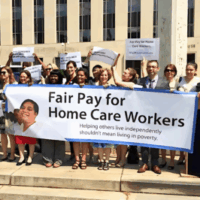Executive Summary
This report exposes a world of work in which the core protections that many Americans take for granted—the right to be paid at least the minimum wage, the right to be paid for overtime hours, the right to take meal breaks, access to workers’ compensation when injured, and the right to advocate for better working conditions—are failing significant numbers of workers. The sheer breadth of the problem, spanning key industries in the economy, as well as its profound impact on workers, entailing significant economic hardship, demands urgent attention.
In 2008, we conducted a landmark survey of 4,387 workers in low-wage industries in the three largest U.S. cities—Chicago, Los Angeles, and New York City. We used an innovative, rigorous methodology that allowed us to reach vulnerable workers who are often missed in standard surveys, such as unauthorized immigrants and those paid in cash. Our goal was to obtain accurate and statistically representative estimates of the prevalence of workplace violations. All findings are adjusted to be representative of front-line workers (i.e. excluding managers, professional or technical workers) in low-wage industries in the three cities—a population of about 1.64 million workers, or 15 percent of the combined workforce of Chicago, Los Angeles and New York.
Finding 1: Workplace Violations Are Severe and Widespread in Low-Wage Labor Markets
We found that many employment and labor laws are regularly and systematically violated, impacting a significant part of the low-wage labor force in the nation’s largest cities. The framework of worker protections that was established over the last 75 years is not working. Here we summarize only key violations; Table 3.1 lists all the violations measured in our study.
Minimum wage violations:
- Fully 26 percent of workers in our sample were paid less than the legally required minimum wage in the previous work week.*
- These minimum wage violations were not trivial in magnitude: 60 percent of workers were underpaid by more than $1 per hour.
Overtime violations:
- Over a quarter of our respondents worked more than 40 hours during the previous week. Of those, 76 percent were not paid the legally required overtime rate by their employers.
- Like minimum wage violations, overtime violations were of substantial magnitude. The average worker with a violation had put in 11 hours of overtime—hours that were either underpaid or not paid at all.
“Off-the-clock” violations:
- Nearly a quarter of the workers in our sample came in early and/or stayed late after their shift during the previous work week. Of these workers, 70 percent did not receive any pay at all for the work they performed outside of their regular shift.
Meal break violations:
- The large majority of our respondents (86 percent) worked enough consecutive hours to be legally entitled to at least one meal break during the previous week. Of these workers, more than two-thirds (69 percent) received no break at all, had their break shortened, were interrupted by their employer, or worked during the break—all of which constitute a violation of meal break law.
Pay stub violations and illegal deductions:
- In California, Illinois and New York, workers are required to receive documentation of their earnings and deductions, regardless of whether they are paid in cash or by check. However, 57 percent of workers in our sample did not receive this mandatory documentation in the previous work week.
- Employers are generally not permitted to take deductions from a worker’s pay for damage or loss, work-related tools or materials or transportation. But 41 percent of respondents who reported deductions from their pay in the previous work week were subjected to these types of illegal deductions.
Tipped job violations:
- Of the tipped workers in our sample, 30 percent were not paid the tipped worker minimum wage (which in Illinois and New York is lower than the regular state minimum wage).
- In addition, 12 percent of tipped workers experienced tip stealing by their employer or supervisor, which is illegal.
Illegal employer retaliation:
We found that when workers complained about their working conditions or tried to organize a union, employers often responded by retaliating against them. Just as important, many workers never made complaints in the first place, often because they feared retaliation by their employer.
- One in five workers in our sample reported that they had made a complaint to their employer or attempted to form a union in the last year. Of those, 43 percent experienced one or more forms of illegal retaliation from their employer or supervisor. For example, employers fired or suspended workers, threatened to call immigration authorities, or threatened to cut workers’ hours or pay.
- Another 20 percent of workers reported that they did not make a complaint to their employer during the past 12 months, even though they had experienced a serious problem such as dangerous working conditions or not being paid the minimum wage. Half were afraid of losing their job, 10 percent were afraid they would have their hours or wages cut, and 36 percent thought it would not make a difference.
Workers’ compensation violations:
We found that the workers’ compensation system is not functioning for workers in the low-wage labor market.
- Of the workers in our sample who experienced a serious injury on the job, only 8 percent filed a workers’ compensation claim.
- When workers told their employer about the injury, 50 percent experienced an illegal employer reaction—including firing the worker, calling immigration authorities, or instructing the worker not to file for workers’ compensation.
- About half of workers injured on the job had to pay their bills out-of-pocket (33 percent) or use their health insurance to cover the expenses (22 percent). Workers’ compensation insurance paid medical expenses for only 6 percent of the injured workers in our sample.
When workers are exempt from workplace laws:
- Some workers are either partially or completely exempt from employment and labor laws—either because of archaic exemptions of specific industries and occupations, or because they are considered to be independent contractors.
- We surveyed one group of workers that is often considered exempt from coverage: “in-home” child care workers who provide care in their own homes. When we analyzed their working conditions (separately from the rest of the sample), we found that 89 percent earned less than the minimum wage. This finding underscores the need to ensure that all workers who are in an employment relationship receive full legal protection.
Finding 2: Job and Employer Characteristics Are Key to Understanding Workplace Violations
Workplace violations are ultimately the result of decisions made by employers—whether to pay the minimum wage or overtime, whether to give workers meal breaks, and how to respond to complaints about working conditions. We found that workplace violations are profoundly shaped by job and employer characteristics.
- Violation rates varied significantly by industry. For example, minimum wage violation rates were most common in apparel and textile manufacturing, personal and repair services, and in private households (all of which had violation rates in excess of 40 percent). Violation rates were substantially lower in residential construction, social assistance and education, and home health care (at 12 to 13 percent). Industries such as restaurants, retail and grocery stores, and warehousing fell into the middle of the range, with about 20 to 25 percent of their workers experiencing a minimum wage violation.
- Violation rates also varied significantly by occupation. For example, childcare workers had very high minimum wage (66 percent) and overtime (90 percent) violation rates. More representative were occupations such as cashiers, who had a minimum wage violation rate of 21 percent and an overtime violation rate of 59 percent.
- Workers who were paid a flat weekly rate or paid in cash had much higher violation rates than those paid a standard hourly rate or by company check.
- Workers at businesses with less than 100 employees were at greater risk of experiencing violations than those at larger businesses. But workers in big companies were not immune: nearly one in six had a minimum wage violation in the previous week, and of those who worked overtime, 53 percent were not paid time and a half.
- Not all employers violate the law. We found a range of workplace practices—offering health insurance, providing paid vacation and sick days, and giving raises—that were associated with lower violation rates. This suggests that employers’ decisions about whether or not to comply with the law are part of a broader business strategy shaping the workplace.
Finding 3: All Workers Are at Risk of Workplace Violations
Workplace violations are not limited to immigrant workers or other vulnerable groups in the labor force— everyone is at risk, although to different degrees.
- Women were significantly more likely than men to experience minimum wage violations, and foreign-born workers were nearly twice as likely as their U.S.-born counterparts to have a minimum wage violation.
- The higher minimum wage violation rate for foreign-born respondents was concentrated among women—especially women who are unauthorized immigrants.
- Foreign-born Latino workers had the highest minimum wage violation rates of any racial/ethnic group. But among U.S.-born workers, there were significant race differences: African-American workers had a violation rate triple that of their white counterparts (who had by far the lowest violation rates in the sample).
- Higher levels of education, longer job tenure, and English proficiency (for immigrants) each offered some protection from minimum wage violations. But even college-educated workers and those who had been with their employers for five or more years were still at significant risk.
- Overtime, off-the-clock and meal break violations generally varied little by worker characteristics. On the whole, job and employer characteristics were more powerful predictors of the workplace violations considered in this study.
Weekly Wage Theft in America’s Cities
Wage theft not only depresses the already meager earnings of low-wage workers, but also adversely impacts their communities and the local economies of which they are a part.
- Workers: More than two-thirds (68 percent) of our sample experienced at least one pay-related violation in the previous work week. The average worker lost $51, out of average weekly earnings of $339. Assuming a full-time, full-year work schedule, we estimate that these workers lost an average of $2,634 annually due to workplace violations, out of total earnings of $17,616. That translates into wage theft of 15 percent of earnings.
- Communities: We estimate that in a given week, approximately 1,114,074 workers in the three cities combined have at least one pay-based violation. Extrapolating from this figure, front-line workers in low-wage industries in Chicago, Los Angeles and New York City lose more than $56.4 million per week as a result of employment and labor law violations.
Fulfilling the Promise of Worker Protections in America
Everyone has a stake in addressing the problem of workplace violations. When impacted workers and their families struggle in poverty and constant economic insecurity, the strength and resiliency of local communities suffer. When unscrupulous employers violate the law, responsible employers are forced into unfair competition, setting off a race to the bottom that threatens to bring down standards throughout the labor market. And when significant numbers of workers are underpaid, tax revenues are lost.
Three principles should drive the development of a new policy agenda to protect the rights of workers.
- Strengthen government enforcement of employment and labor laws: Public policy should leverage the resources and power that reside in agencies responsible for enforcing worker protections. This will require additional staffing, but more important, new strategies are needed to address the reality that workplace violations are becoming standard practice in many low-wage industries.
- Update legal standards for the 21st century labor market: Weak employment and labor laws open the door to low-road business strategies focused on illegally cutting labor costs. Raising the minimum wage, updating health and safety standards, ending exclusions that deny workers coverage, and strengthening the right of workers to organize through labor law reform—all are key improvements that would raise compliance in the workplace and improve the competitive position of employers who play by the rules.
- Establish equal status for immigrants in the workplace: The best inoculation against workplace violations is ensuring that workers know their rights, have full status under the law to assert them, have access to sufficient legal resources, and do not fear retaliation. But for unauthorized immigrant workers today, this can be a near impossibility. Any policy initiative to reduce workplace violations must prioritize equal protection and equal status in national immigration reform, and ensure status-blind enforcement of employment and labor laws.
* In this summary we are not able to elaborate the complexity of employment and labor laws; see the main report for details on federal and state legal standards and coverage.
Related to
Related Resources
All resourcesNELP’s New York City Worker Justice Agenda

Policy & Data Brief
The Case for Private Enforcement of Workers’ Rights

Policy & Data Brief
Comments on a Proposed Rule Excluding Home Care Workers from Federal Wage Protections

Comments & Letters
